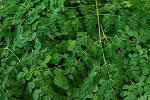 Take a second look at that lowly malunggay in your backyard. Oftentimes we just ignore it and we would rather spend our precious money for those expensive vegetables in the market. Little did we know that this very ordinary vegetable is packed with essential vitamins and minerals that our body needs.
Take a second look at that lowly malunggay in your backyard. Oftentimes we just ignore it and we would rather spend our precious money for those expensive vegetables in the market. Little did we know that this very ordinary vegetable is packed with essential vitamins and minerals that our body needs.
Fresh malunggay (Moringa oleifera) leaves are rich in vitamins A, B, C, calcium, potassium, protein and iron. Studies showed that malunggay gives a feeling of wellness and at the same time balances sugar and cholesterol content in the body. Leaves can be prescribed to treat anemia. Dubbed as miracle vegetable or the power gulay, malunggay is now being processed as food fortificant, food supplement, and even potent medicine.
Seeing this great agribusiness potential of malunggay, Agriculture Secretary Arthur C. Yap urged the agriculture stakeholders to increase the production and diversify the uses of this vegetable and thereby help in fighting hunger and malnutrition especially in the rural areas.
The Bureau of Agricultural Research (BAR) included malunggay in its Indigenous Plants for Health and Wellness Program and identified the development of malunggay as priority project.
For its part, the DA RFU 5, through its research arm, the Bicol Integrated Agricultural Research Center (BIARC), is developing and piloting promising technologies for the banner commodities of Bicol. One of which is malunggay. The DA-5 Regional Executive Director Dr. Jose V. Dayao had also instructed the six Research Outreach Stations (ROS) in Bicol to facilitate the propagation of planting materials in support to the program.
Developing food products from malunggay
Under the on-going DA-BAR funded project entitled “Development, On-Farm Demonstration and Piloting of Promising Value-adding Technologies for Export Potential and Banner Commodities of Bicol,” BIARC has found new ways to integrate malunggay in various food preparations as well as packaged it into different product lines. These include malunggay tea, instant juice, malunggay powder, polvoron, yema, cookies, noodles, pastillas, and the malunggay surprise.
Malunggay leaves were separated from the stalks and were either oven dried or sun dried. They call these dried leaves as “malunggay tea.” The pounded dried leaves of malunggay, on the other hand are turned into “moringa powder” which can be mixed into common Filipino delicacies such as soups, sauces, instant noodles, polvoron, cookies, and chocolates as an added ingredient. In this way, children who are not very fond of vegetables get to ingest essential nutrients present in malunggay without knowing it. This newly developed products has a shelf life of six months at the most depending on the packaging materials used.
BIARC is now on the process of establishing the nutrient facts of these products. They are also conducting further trials to improve its shelf life and enhance the packaging and presentation of the products.
Enhancing the role of R&D and technology commercialization
This initiative of BIARC is being supported by BAR under its National Technology Commercialization Program (NTCP), together with the GMA High Value Commercial Crops (HVCC) Program of the Department of Agriculture RFU 5.
“Through the help of the NTCP, BIARC was able to create awareness regarding the importance of this valuable commodity and at the same time promote the products developed from malunggay,” Dr. de los Santos said.
NTCP, one of BAR’s flagship programs, is aimed at facilitating the commercialization of newly developed technologies for maximum utilization. Technologies shall be strategically placed and transferred to areas and communities that needed them most. This strategy shall enhance technology transfer as well as realize the impact of research results.
“The processing technologies for Moringa developed by BIARC are a prime example of technologies generated by DA-BAR supported projects which are already ripe for commercialization,” she added. This she considers a big role in encouraging the pursuit of new production and processing technologies for malunggay products.
BIARC participated in local and international trade fairs, technology demonstrations, technology fora, trainings and seminars that draw a lot of interested participants. The group also conducted sensory evaluation and consumer acceptability trials as part of their promotional and marketing strategies. They did market matching, domestic marketing trials, and export marketing trials.
The malunggay industry is still very young in the Philippines. Dr. delos Santos envisions that after the implementation of the project, appropriate POTs can be developed and new products are identified from malunggay.
“In addition, expanded markets for these products shall be developed as additional source of livelihood in the countryside. At the same time, majority of the people in the community will utilize malunggay as a cheap source of nutrition and” she ended.
Source: Ma. Eloisa E. Hernandez and Lovella P. Guarin- bar.gov.ph, October-December 2008 Volume 10 Issue No. 4
Do you like this Money making business ideas? then please consider subscribing to our RSS feed and have new business ideas sent directly to your inbox.
Gusto ko magstart nang business na ito pwdi ba gawin ito sa bahay lng. Na hindi ka magttaayo ng stablisment or manufacturing company?
kon magtanim ako ng maramihan na malunggay saan kon ibinta ng maramihan at sino ang mga supplier at magkano
This is a great idea of making business out from malunggay plant. Thanks for sharing some of the idea needed to start an agribusiness.